| Solar eclipse of October 12, 1958 | |
|---|---|
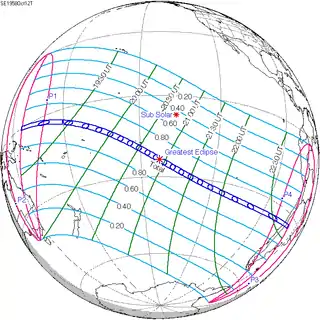 Map | |
| Type of eclipse | |
| Nature | Total |
| Gamma | −0.2951 |
| Magnitude | 1.0608 |
| Maximum eclipse | |
| Duration | 311 sec (5 m 11 s) |
| Coordinates | 24°00′S 142°24′W / 24°S 142.4°W |
| Max. width of band | 209 km (130 mi) |
| Times (UTC) | |
| Greatest eclipse | 20:55:28 |
| References | |
| Saros | 133 (42 of 72) |
| Catalog # (SE5000) | 9417 |
A total solar eclipse occurred on October 12, 1958. A solar eclipse occurs when the Moon passes between Earth and the Sun, thereby totally or partly obscuring the image of the Sun for a viewer on Earth. A total solar eclipse occurs when the Moon's apparent diameter is larger than the Sun's, blocking all direct sunlight, turning day into darkness. Totality occurs in a narrow path across Earth's surface, with the partial solar eclipse visible over a surrounding region thousands of kilometres wide. Totality was visible in Tokelau, Cook Islands, French Polynesia, Chile and Argentina. This solar eclipse occurred over 3 months after the final game of 1958 FIFA World Cup.
Related eclipses
Solar eclipses of 1957–1960
This eclipse is a member of a semester series. An eclipse in a semester series of solar eclipses repeats approximately every 177 days and 4 hours (a semester) at alternating nodes of the Moon's orbit.[1]
| Solar eclipse series sets from 1957–1960 | ||||
|---|---|---|---|---|
| Descending node | Ascending node | |||
| Saros | Map | Saros | Map | |
| 118 |  1957 April 30 Annular (non-central) |
123 |  1957 October 23 Total (non-central) | |
| 128 |  1958 April 19 Annular |
133 |  1958 October 12 Total | |
| 138 |  1959 April 8 Annular |
143 | 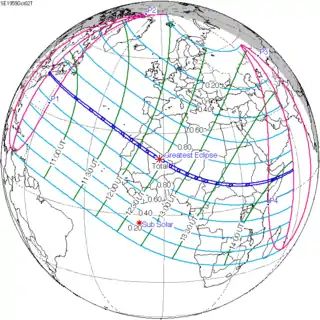 1959 October 2 Total | |
| 148 |  1960 March 27 Partial |
153 |  1960 September 20 Partial | |
Saros 133
Solar Saros 133, repeating every 18 years, 11 days, contains 72 events. The series started with a partial solar eclipse on July 13, 1219. It contains annular eclipses from November 20, 1435, through January 13, 1526, with a hybrid eclipse on January 24, 1544. It has total eclipses from February 3, 1562, through June 21, 2373. The series ends at member 72 as a partial eclipse on September 5, 2499. The longest duration of totality was 6 minutes, 49.97 seconds on August 7, 1850.[2] The total eclipses of this saros series are getting shorter and farther south with each iteration. All eclipses in this series occurs at the Moon’s ascending node.
| Series members 30–56 occur between 1742 and 2211 | ||
|---|---|---|
| 30 | 31 | 32 |
| June 3, 1742 | June 13, 1760 | 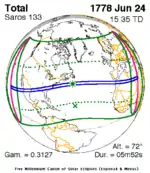 June 24, 1778 |
| 33 | 34 | 35 |
| July 4, 1796 | July 17, 1814 | July 27, 1832 |
| 36 | 37 | 38 |
| August 7, 1850 | 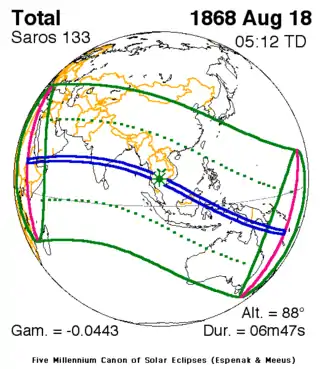 August 18, 1868 |
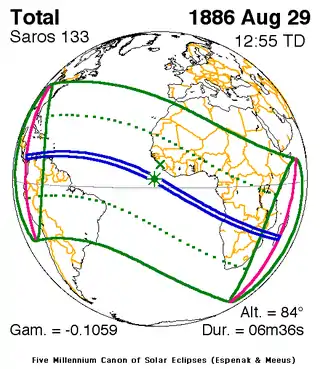 August 29, 1886 |
| 39 | 40 | 41 |
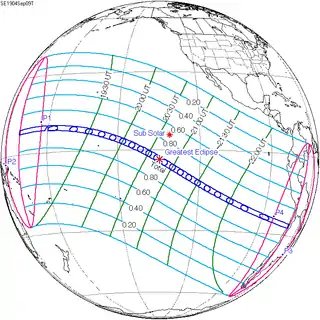 September 9, 1904 |
 September 21, 1922 |
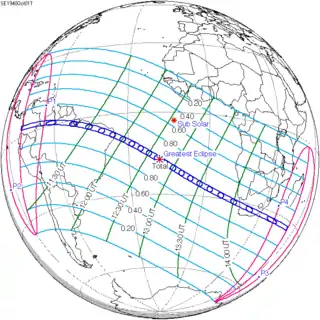 October 1, 1940 |
| 42 | 43 | 44 |
 October 12, 1958 |
 October 23, 1976 |
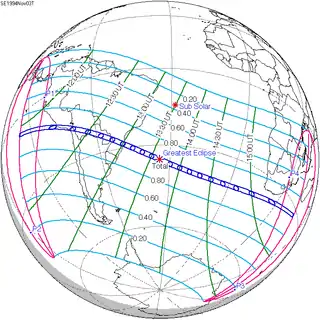 November 3, 1994 |
| 45 | 46 | 47 |
 November 13, 2012 |
 November 25, 2030 |
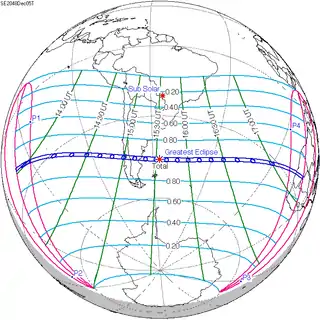 December 5, 2048 |
| 48 | 49 | 50 |
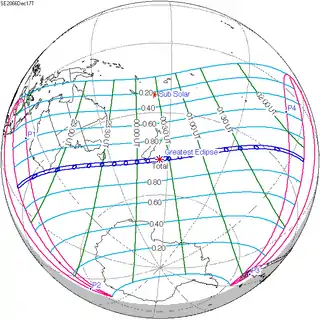 December 17, 2066 |
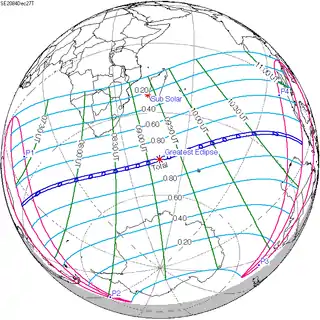 December 27, 2084 |
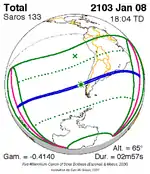 January 8, 2103 |
| 51 | 52 | 53 |
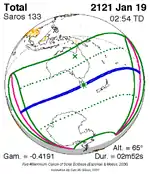 January 19, 2121 |
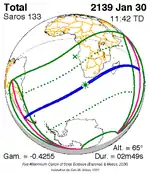 January 30, 2139 |
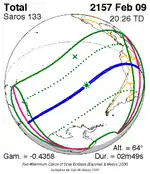 February 9, 2157 |
| 54 | 55 | 56 |
 February 21, 2175 |
 March 3, 2193 |
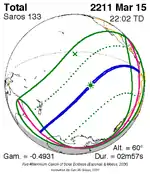 March 15, 2211 |
Tritos series
This eclipse is a part of a tritos cycle, repeating at alternating nodes every 135 synodic months (≈ 3986.63 days, or 11 years minus 1 month). Their appearance and longitude are irregular due to a lack of synchronization with the anomalistic month (period of perigee), but groupings of 3 tritos cycles (≈ 33 years minus 3 months) come close (≈ 434.044 anomalistic months), so eclipses are similar in these groupings.
| Series members between 1801 and 2100 | |||
|---|---|---|---|
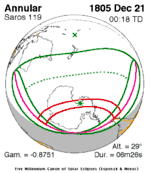 December 21, 1805 (Saros 119) |
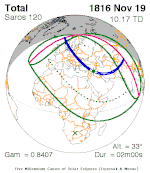 November 19, 1816 (Saros 120) |
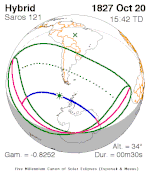 October 20, 1827 (Saros 121) | |
 September 18, 1838 (Saros 122) |
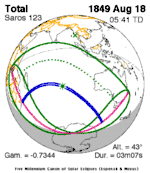 August 18, 1849 (Saros 123) |
 July 18, 1860 (Saros 124) | |
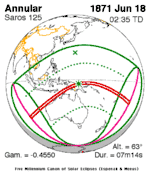 June 18, 1871 (Saros 125) |
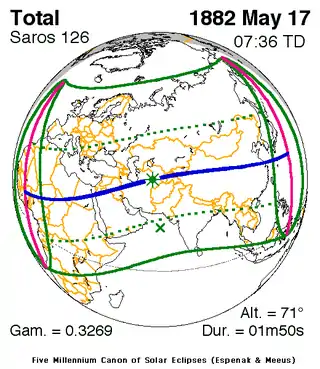 May 17, 1882 (Saros 126) |
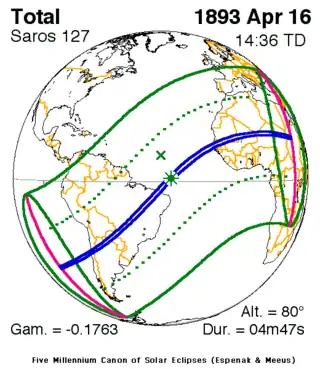 April 16, 1893 (Saros 127) | |
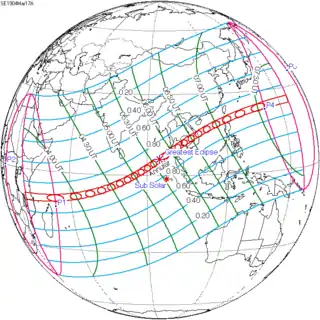 March 17, 1904 (Saros 128) |
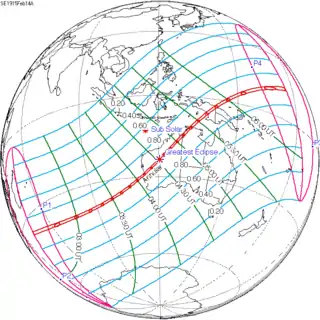 February 14, 1915 (Saros 129) |
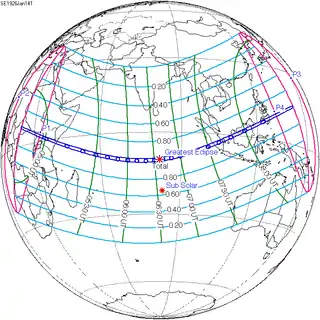 January 14, 1926 (Saros 130) | |
 December 13, 1936 (Saros 131) |
 November 12, 1947 (Saros 132) |
 October 12, 1958 (Saros 133) | |
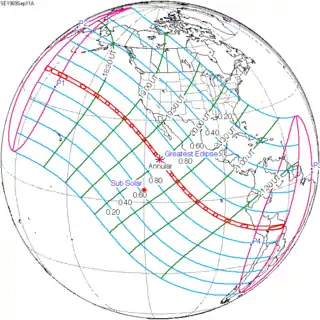 September 11, 1969 (Saros 134) |
 August 10, 1980 (Saros 135) |
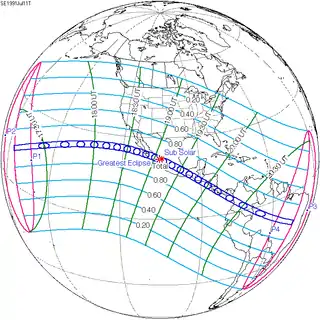 July 11, 1991 (Saros 136) | |
 June 10, 2002 (Saros 137) |
 May 10, 2013 (Saros 138) |
 April 8, 2024 (Saros 139) | |
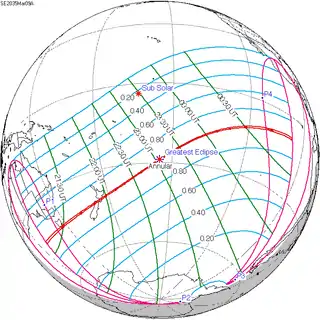 March 9, 2035 (Saros 140) |
 February 5, 2046 (Saros 141) |
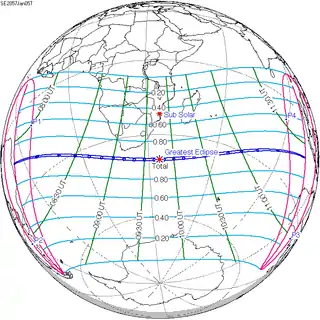 January 5, 2057 (Saros 142) | |
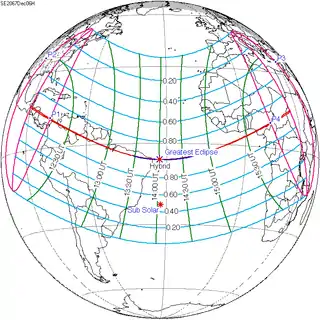 December 6, 2067 (Saros 143) |
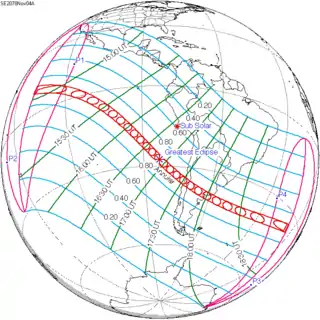 November 4, 2078 (Saros 144) |
 October 4, 2089 (Saros 145) | |
 September 4, 2100 (Saros 146) |
|||
In the 22nd century:
- Solar saros 147: annular solar eclipse of August 4, 2111
- Solar saros 148: total solar eclipse of July 4, 2122
- Solar saros 149: total solar eclipse of June 3, 2133
- Solar saros 150: annular solar eclipse of May 3, 2144
- Solar saros 151: annular solar eclipse of April 2, 2155
- Solar saros 152: total solar eclipse of March 2, 2166
- Solar saros 153: annular solar eclipse of January 29, 2177
- Solar saros 154: annular solar eclipse of December 29, 2187
- Solar saros 155: total solar eclipse of November 28, 2198
In the 23rd century:
- Solar saros 156: annular solar eclipse of October 29, 2209
- Solar saros 157: annular solar eclipse of September 27, 2220
- Solar saros 158: total solar eclipse of August 28, 2231
- Solar saros 159: partial solar eclipse of July 28, 2242
- Solar saros 160: partial solar eclipse of June 26, 2253
- Solar saros 161: partial solar eclipse of May 26, 2264
- Solar saros 162: partial solar eclipse of April 26, 2275
- Solar saros 163: partial solar eclipse of March 25, 2286
- Solar saros 164: partial solar eclipse of February 22, 2297
Metonic series
The metonic series repeats eclipses every 19 years (6939.69 days), lasting about 5 cycles. Eclipses occur in nearly the same calendar date. In addition, the octon subseries repeats 1/5 of that or every 3.8 years (1387.94 days). All eclipses in this table occur at the Moon's ascending node.
| 22 eclipse events between December 24, 1916 and July 31, 2000 | ||||
|---|---|---|---|---|
| December 24–25 | October 12–13 | July 31-Aug 1 | May 18–20 | March 7–8 |
| 91 | 93 | 95 | 97 | 99 |
| December 23, 1878 | October 12, 1882 | July 31, 1886 | May 18, 1890 | March 7, 1894 |
| 101 | 103 | 105 | 107 | 109 |
| December 23, 1897 | October 12, 1901 | August 1, 1905 | May 19, 1909 | March 8, 1913 |
| 111 | 113 | 115 | 117 | 119 |
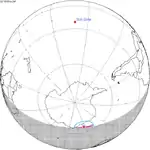 December 24, 1916 |
October 12, 1920 |  July 31, 1924 |
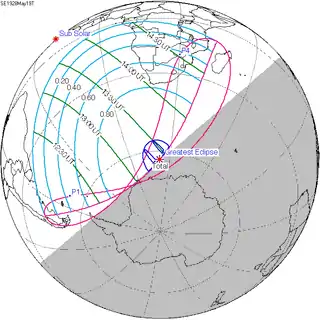 May 19, 1928 |
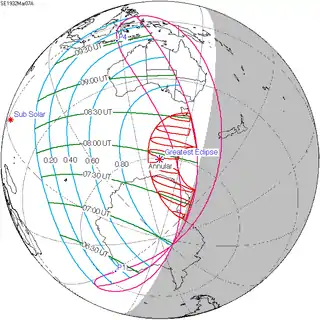 March 7, 1932 |
| 121 | 123 | 125 | 127 | 129 |
 December 25, 1935 |
 October 12, 1939 |
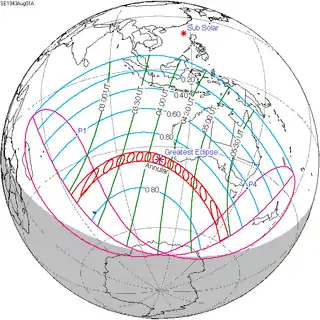 August 1, 1943 |
 May 20, 1947 |
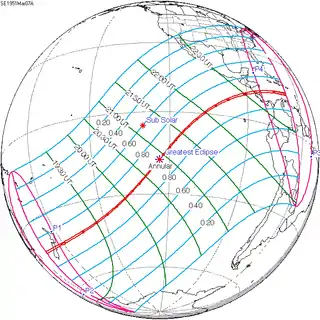 March 7, 1951 |
| 131 | 133 | 135 | 137 | 139 |
 December 25, 1954 |
 October 12, 1958 |
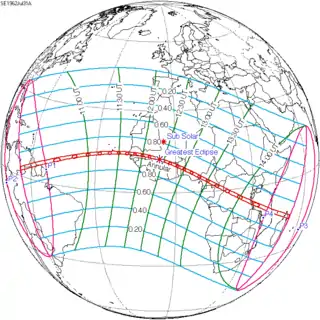 July 31, 1962 |
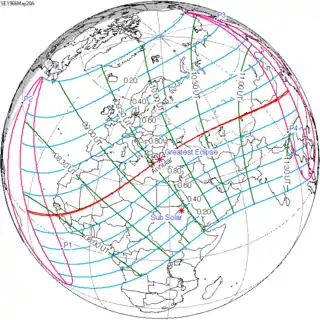 May 20, 1966 |
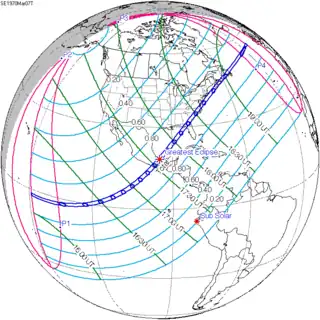 March 7, 1970 |
| 141 | 143 | 145 | 147 | 149 |
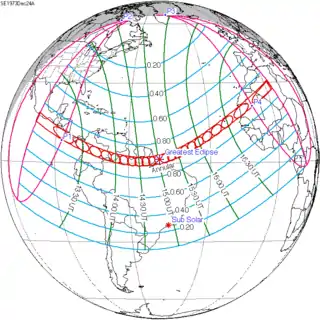 December 24, 1973 |
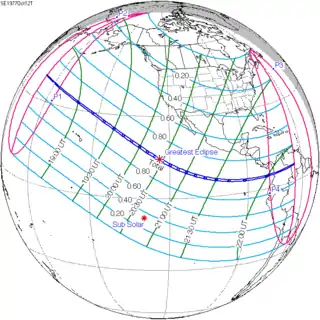 October 12, 1977 |
 July 31, 1981 |
 May 19, 1985 |
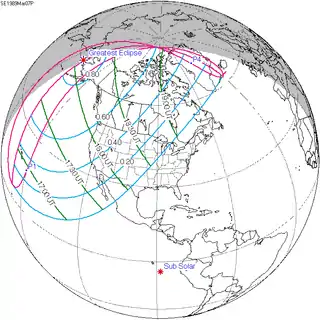 March 7, 1989 |
| 151 | 153 | 155 | 157 | 159 |
 December 24, 1992 |
 October 12, 1996 |
 July 31, 2000 |
May 19, 2004 | March 7, 2008 |
| 161 | 163 | 165 | 167 | 169 |
| December 24, 2011 | October 13, 2015 | August 1, 2019 | May 19, 2023 | March 8, 2027 |
Notes
- ↑ van Gent, R.H. "Solar- and Lunar-Eclipse Predictions from Antiquity to the Present". A Catalogue of Eclipse Cycles. Utrecht University. Retrieved 6 October 2018.
- ↑ http://eclipse.gsfc.nasa.gov/SEsaros/SEsaros133.html
References
- Earth visibility chart and eclipse statistics Eclipse Predictions by Fred Espenak, NASA/GSFC
.jpg.webp)

